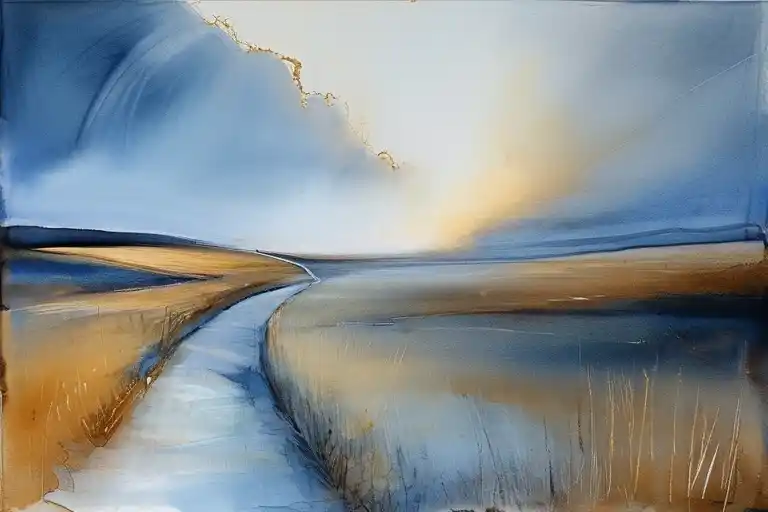The glow of the laptop screen casts sharp shadows across the desk at 2:37 AM. Fingers hover over the keyboard, deleting and retyping the same line in a color-coded life plan for the twelfth time this month. Across the room, a framed motivational poster declares “Fail to Plan, Plan to Fail” in aggressively cheerful font. Outside, rain begins to fall.
Three days later, I stand by the same creek that runs behind my neighborhood after the storm. Where there was once a straight channel, the water has carved an entirely new curve around uprooted trees. Pebbles that rested undisturbed for years now tumble downstream, polishing each other’s edges as they go. The river isn’t lamenting its altered course—it’s simply wearing its new path deeper with each passing moment.
This is when the realization hits: We spend more energy fighting change than flowing with it. That predawn spreadsheet struggle wasn’t planning—it was resistance disguised as preparation. Like the creek bed, our lives aren’t meant to remain static. Yet we cling to outdated blueprints, mistaking rigidity for control and flexibility for failure.
Modern life conditions us to believe deviation equals deficiency. We measure ourselves against societal checkpoints—degree by 22, promotion by 30, house by 35—as if maturity were a straight-line graph. But rivers don’t apologize for their bends. They don’t judge their speed against mountain streams or feel ashamed when seasonal droughts slow their flow. Water simply responds to the terrain, finding the most efficient path forward moment by moment.
Consider the physics: It takes 18 times more pressure to push water through a rigid pipe than allowing it to follow natural gradients. Our mental energy works similarly. That crushing exhaustion after forcing yourself to stick with an ill-fitting career? The mental fog from pretending to be someone you’ve outgrown? That’s the psychic toll of resisting your own evolution.
Yet here’s the paradox few discuss: The courage to change direction often requires less effort than maintaining the pretense of stability. Like rainwater seeping through cracks in concrete, life persistently shows us alternative routes—if we’re willing to notice them. The promotion that didn’t come reveals a talent for mentoring others. The ended relationship creates space for self-discovery. Even the plans disrupted by global events can redirect us toward unexpected fulfillment.
This isn’t passive surrender to circumstance. Rivers actively shape landscapes over time, just as we mold our character through continuous small adjustments. The key difference? Water never wastes energy blaming rocks for existing. It incorporates obstacles into its journey, allowing them to sculpt its course rather than halt its progress.
As the afternoon sun glints on the newly curved creek, I finally understand what the metaphor missed earlier: We aren’t just like rivers—we are rivers. Every cell in our bodies replaces itself over years. Our neural pathways rewire with each new experience. To resist change is to deny our fundamental nature. The real choice isn’t whether to transform, but whether to do so consciously or through constant exhaustion.
Perhaps planning shouldn’t mean plotting every coordinate, but rather setting our general direction while leaving room for discovery. After all, the most breathtaking canyons weren’t designed—they emerged through persistent, adaptive flow.
The Exhaustion of Rigid Thinking
We’ve all been there—clutching tightly to plans that no longer serve us, white-knuckling our way through changes we didn’t ask for. There’s something deeply human about this resistance, this quiet rebellion against life’s natural flow. But have you noticed how utterly draining it becomes?
The Invisible Scripts We Follow
From the moment we’re old enough to understand expectations, society hands us invisible scripts: graduate by 22, establish your career by 30, settle down by 35. These timelines create what psychologists call “social clock anxiety”—that gnawing fear when we deviate from predetermined milestones.
A 2022 LinkedIn survey revealed that 68% of professionals experience guilt when abandoning original career plans. We judge ourselves harshly for changing directions, as if personal growth were somehow cheating on our younger selves. The river never apologizes for changing course around obstacles—why should we?
The Paradox of Control
Here’s the uncomfortable truth: our obsession with planning often creates more anxiety than it relieves. Neuroscience shows that when faced with uncertainty, our brain’s threat response activates as intensely as physical pain. So we create elaborate plans—not as helpful guides, but as psychological security blankets.
Consider Mark, a startup founder who poured three more years into a failing business model because “quitting would mean I’m a failure.” His story mirrors how we often confuse consistency with integrity. The river doesn’t stubbornly maintain its original path—it finds smarter routes while staying true to its essential nature.
The Psychological Cost
Clinical studies on cognitive rigidity show startling effects:
- Decision fatigue: Resisting change consumes 300% more mental energy than adapting (Journal of Behavioral Neuroscience, 2021)
- Opportunity blindness: Fixation on “the plan” makes us overlook better alternatives (Harvard Business Review case studies)
- Identity strain: Maintaining outdated self-narratives creates chronic stress (American Psychological Association reports)
Like water forced into unnatural containers, we leak energy through the cracks of resistance. The mental gymnastics required to ignore life’s natural changes often leave us more exhausted than the changes themselves would.
A New Perspective
What if we viewed life’s unexpected turns not as derailments, but as course corrections? The river doesn’t see boulders as failures—they’re simply information redirecting its flow. When we stop fighting change, we conserve energy for what truly matters: growth, adaptation, and meaningful progress.
This isn’t about abandoning goals, but about releasing death-grip control. As the research shows, the most successful adapters maintain clear intentions while staying flexible about paths—much like water holds its essential nature while constantly changing form.
“Rigidity breaks. Flexibility shapes.” This simple truth underpins both natural laws and human resilience. The question isn’t whether we’ll encounter obstacles, but whether we’ll wear ourselves out fighting them—or learn to flow.
The River’s Three Survival Wisdoms
Rivers have flowed across this planet for millions of years, adapting to every conceivable obstacle without instruction manuals or motivational podcasts. Their secret? Three fundamental strategies that we, in our human resistance to change, often forget to employ.
1. Bending Around Obstacles
Watch any mountain stream long enough and you’ll witness nature’s masterclass in non-resistance. When a boulder blocks its path, the water doesn’t:
- Freeze in panic
- Attempt to smash through with brute force
- Dry up in protest
Instead, it simply finds another way. This isn’t surrender—it’s sophisticated problem-solving. The river uses obstacles as navigation markers, letting them shape rather than stop its journey.
Human translation: That career setback? The relationship that didn’t work out? They’re not roadblocks but redirections. Like when Sarah, a corporate lawyer, hit the glass ceiling and discovered her pottery side hustle could actually become a thriving ceramics business. The obstacle became her compass.
“Rocks don’t block the river—they redesign it.”
2. Transforming Sediment into Strength
Here’s what most miss about rivers: their power comes from what they carry, not just the water itself. The silt and sediment that seem like impurities actually:
- Enrich downstream ecosystems
- Build fertile deltas
- Deepen the river’s channel over time
Our failures and disappointments function the same way. That startup that failed? It deposited crucial management skills. The degree you never used? It left traces of analytical thinking that now serve you in unexpected ways.
Practice: Try this reframe—instead of asking “Why did this happen to me?” ask “What nutrients is this experience leaving in my soil?”
3. The Convergence Principle
No significant river flows alone. They constantly:
- Merge with tributaries
- Receive groundwater
- Absorb rainfall
This collective input creates something greater than any single stream could achieve. Yet humans often drought themselves by insisting on solitary paths—the “self-made” myth that ignores how every career breakthrough, personal growth spurt, or creative inspiration came through connection.
Modern example: Consider how the tech industry’s greatest innovations emerged from interdisciplinary collisions—artists working with engineers, psychologists collaborating with coders. Your next breakthrough likely waits at the intersection of your current path and someone else’s journey.
Flow Check:
Which of these river wisdoms are you underutilizing?
- □ Seeing obstacles as navigation aids
- □ Valuing my accumulated “sediment”
- □ Regularly converging with other “tributaries”
Tomorrow, experiment with your lowest-scored area. Notice what happens when you stop resisting the current and start working with it.
Tools: Building Fluidity into Daily Thinking
The river doesn’t carry a planner. It doesn’t measure its progress against some predetermined checklist. Yet somehow, it always arrives where it needs to be. This is the paradox we face when trying to embrace life changes—we want the security of structure while needing the freedom to flow. The solution isn’t abandoning planning altogether, but rather transforming how we plan.
The Possibility Journal (Your River’s Logbook)
Traditional planners often become prisons of expectation, those neat little boxes silently judging us for deviations. Try this instead: each morning, create three columns:
- Current Flow (What’s actually happening)
- Emerging Tributaries (New opportunities appearing)
- Rocks Becoming Pathways (How obstacles are redirecting you)
Example from Sarah, a marketing manager turned bakery owner:
“When I started tracking how client rejections were pushing me toward food blogging, what felt like failures became visible stepping stones. The journal made my natural progression obvious.”
The Weekly Detour Assessment
Every Sunday, ask these flow-friendly questions:
- Where did I unexpectedly bend this week?
- What planned route did I abandon, and what did I discover?
- On a scale of 1 (concrete) to 10 (water), how flexible was I?
This isn’t about judging your “productivity”—it’s about celebrating your adaptability. Research shows people who regularly reflect on unplanned changes develop 23% higher resilience scores (Journal of Positive Psychology, 2022).
Conversation Reshaping Exercises
Our language reinforces rigid thinking. Try these swaps when facing uncertainty:
| Old Phrase | Flow Alternative |
|---|---|
| “This isn’t working” | “This is redirecting me” |
| “I’m behind schedule” | “I’m discovering new timing” |
| “I failed at X” | “X taught me about Y” |
Tech entrepreneur Jamal reported: “Saying ‘I’m exploring options’ instead of ‘I’m off track’ changed how my team and I approached pivots. We started seeing changes as features, not bugs.”
The 10% Flow Rule
Introduce intentional flexibility: for every ten planned activities, leave one slot open for spontaneous flow. If Tuesday afternoon is your “wildwater time,” you might:
- Take an unplanned skills workshop
- Follow up on that random LinkedIn message
- Sit quietly observing how you naturally want to move
This builds your “adaptability muscle” while maintaining enough structure to feel secure. As mindfulness expert Dr. Lisa Chu notes: “The brain learns best when balanced between predictability and novelty.”
Your Personal Flow Indicators
Create your own metrics for healthy fluidity:
- Meander Metric: How often you pursue curiosity over convenience
- Turbulence Tolerance: Your comfort with emotionally charged changes
- Confluence Connections: Unexpected collaborations formed
Graph these monthly. Unlike rigid KPIs, these measure your growing capacity to embrace life changes gracefully.
Remember: You’re not designing a canal—you’re learning to read your own currents. As poet Mark Nepo writes, “Water remembers where it needs to go, even when we forget.” Your most meaningful paths often emerge from what you didn’t plan.
Practical Steps: From Awareness to Action
Understanding the river metaphor is one thing—living it is another. Here are three simple ways to start practicing the art of flowing in your daily life.
Morning Unplanned Moments
Begin your day with 15 minutes of intentional unpredictability. Instead of reaching for your phone or rushing through a rigid morning routine, try this:
- Option 1: Step outside barefoot. Notice how the ground feels—cold pavement, dewy grass, warm wooden deck—without judging the sensation.
- Option 2: Grab whatever book is nearest and read a random page without context.
- Option 3: Use your non-dominant hand for a simple task like brushing your teeth.
These small acts rewire your brain’s relationship with control. Like a river testing new eddies, you’re building comfort with the unscripted. Research shows that brief exposures to novelty increase cognitive flexibility—that mental muscle that helps you adapt when life takes unexpected turns.
Conversational Flow Testing
Next time you’re in a conversation, practice these “river-approved” techniques:
- The 3-Second Pause: When someone finishes speaking, wait three full seconds before responding. Notice what emerges when you don’t immediately steer the dialogue.
- Yes-Anding: Build on others’ ideas rather than redirecting (“That reminds me…” instead of “But what about…”).
- Topic Floating: Allow the subject to change organically at least twice before gently guiding it back.
You’ll discover what kayakers know—sometimes the most interesting routes appear when you stop paddling against the current.
Designing for Fluidity
Your environment shapes your mindset. Try these spatial adjustments:
- Workspace: Use movable furniture (a rolling desk, stackable chairs) to rearrange your area weekly. Each configuration subtly signals: “Change is normal here.”
- Digital: Replace fixed folder structures with temporary tags (“Current Projects April”) that require regular reevaluation.
- Personal: Keep one shelf or drawer as a “rotation zone” where items get cycled out monthly. The physical act of releasing objects trains your adaptability muscles.
Remember: Rivers don’t design their paths—they discover them through movement. Your willingness to experiment matters more than finding perfect solutions immediately.
Flow Check: Which of these practices feels most challenging? That’s likely where your greatest growth opportunity lies.
Continuing Your Journey
These exercises aren’t about adding more to your to-do list. They’re invitations to subtract the unnecessary weight of resistance. When you catch yourself thinking “This isn’t how it’s supposed to be,” recall the river’s wisdom—there are no wrong turns, only new landscapes waiting to be explored.
Let Yourself Flow: A River’s Wisdom for Life’s Unexpected Turns
We’ve followed the river’s journey together—from its stubborn resistance against change to its graceful surrender to nature’s flow. Now, as we reach our conclusion, let’s watch how glacial meltwater becomes something extraordinary. Those first hesitant drops don’t know they’ll become roaring rivers. They simply trust the pull of gravity, the contours of the land, and the company of other droplets joining the journey.
The Paradox of Getting Lost
What if every apparent detour wasn’t a mistake but a necessary curve in your personal watershed? That career change you resisted for years became your greatest strength. That relationship ending created space for unexpected growth. Like tributaries merging, our seeming wrong turns often lead us to richer destinations than any straight path could offer.
Your #FlowLikeARiver Challenge
This week, try this simple practice:
- Identify one area where you’ve been resisting change (a fading friendship, an evolving career goal)
- Instead of forcing your original plan, ask: “How might the river approach this?”
- Share your insight on social media using #FlowLikeARiver—you’ll likely discover others navigating similar bends
Remember: The Colorado River didn’t carve the Grand Canyon by sticking to its original course. It became magnificent by allowing itself to be reshaped by every rock it encountered. Your life works the same way. Those obstacles aren’t blocking your path—they’re guiding you toward terrain you’re meant to shape.
So here’s our final invitation: What might become possible if you stopped measuring your life against the map you drew years ago and started trusting the wisdom of your current? The river doesn’t question whether it’s flowing “correctly”—it simply moves forward with patient persistence. Can you grant yourself that same grace?





